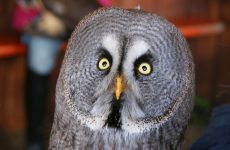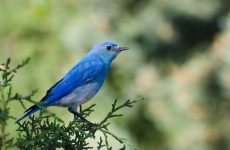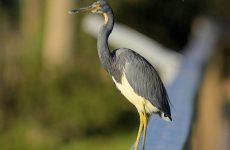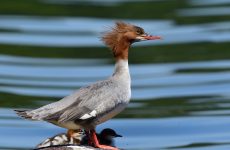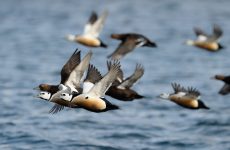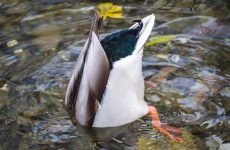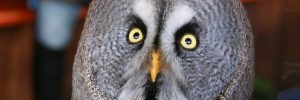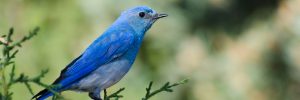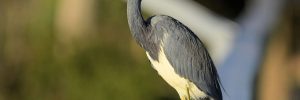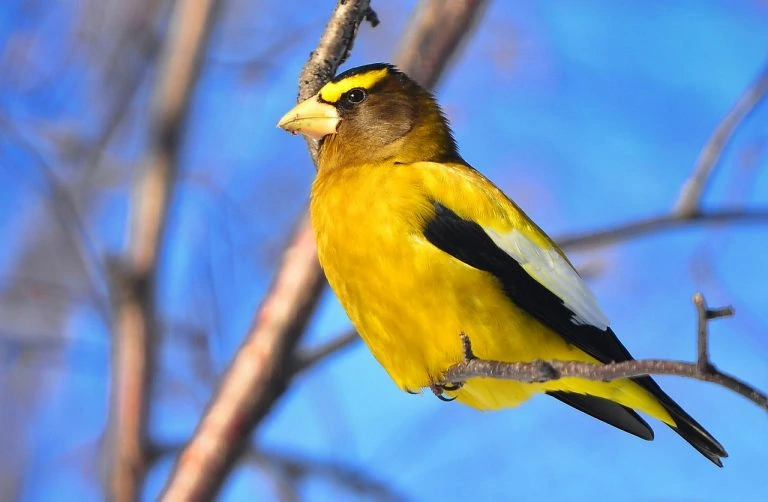
Birds with yellow bellies are easy to identify with this picture and ID guide.
There are lots of birds with yellow bellies that you can spot and many of them are warblers or orioles, especially the female orioles.
Find out all about birds with yellow bellies to help you identify them. These bright and cheery birds can be seen at backyard feeders or out in the fields and forests.
There are many birds with yellow bellies that visit the US and Canada and some migrate and others stay all year.
So read on to identify those birds you have spotted.
35 Birds With Yellow Bellies:
- American Goldfinch
- Common Yellowthroat
- Western Meadowlark
- Lesser Goldfinch
- Prairie Warbler
- Orange-crowned Warbler
- Prothonotary Warbler
- Orchard Oriole Female
- Western Tanager
- Canada Warbler
- Cape May Warbler
- Magnolia Warbler
- Pine Warbler
- Yellow Warbler
- Orchard Oriole Female
- Western Kingbird
- Baltimore Oriole Female
- Altamira Oriole
- Audubon’s Oriole
- Eastern Meadowlark
- Yellow-throated Warbler
- Nashville Warbler
- Palm Warbler
- Cedar Waxwing
- Evening Grosbeak
- Scott’s Oriole
- Spot Breasted Oriole
- Baltimore Oriole Female
- Streaked Backed Oriole Female
- Hooded Oriole
- Wilson’s Warbler
- Hooded Warbler
- Williamson’s Sapsucker Male
- Great Crested Flycatcher
- Yellow-bellied Sapsucker
1. American Goldfinch
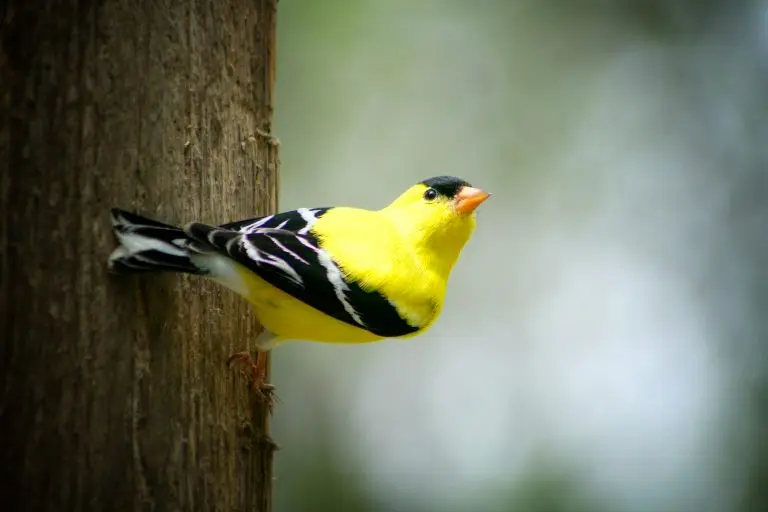
American Goldfinches are popular birds with the males bright yellow and black coloring in spring. The females are more dull brown as are males in winter.
- Length: 4.3-5.1 in (11-13 cm)
- Weight: 0.4-0.7 oz (11-20 g)
- Wingspan: 7.5-8.7 in (19-22 cm)
American Goldfinches can be found in most of North America. They breed in Canada and the Mid-West and Canada before migrating to southern states, they remain all year in the rest of the U.S.
They can be found in weedy fields and overgrown areas foraging for sunflower, thistle, and aster plants. They are also common in suburbs, parks, and backyards.
To attract more American Goldfinches to your backyard try planting thistles and milkweed. They will visit most bird feeders and prefer sunflower seed and nyjer seed.
2. Common Yellowthroat
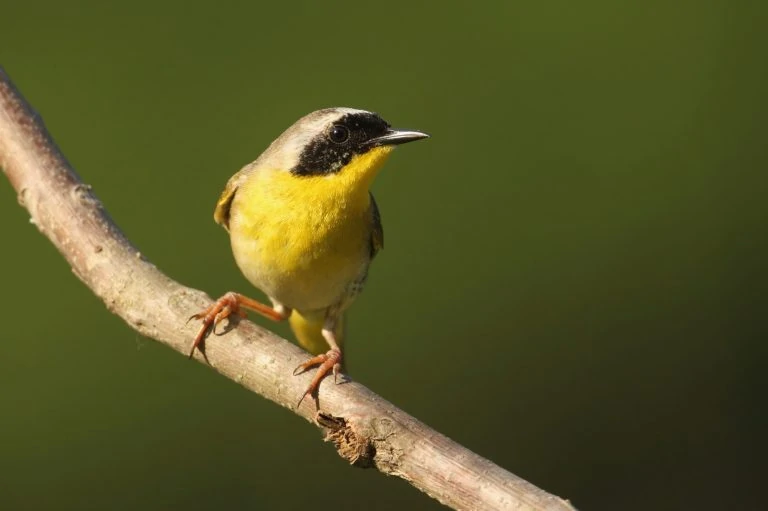
Common Yellowthroats are small songbirds that are brownish on the back and with bright yellow chests and with paler yellow bellies, and with long tails. The males have a black mask across the face. The brightness of the yellow can vary geographically and they may be more olive in parts underneath.
- Length: 4.3-5.1 in (11-13 cm)
- Weight: 0.3-0.3 oz (9-10 g)
- Wingspan: 5.9-7.5 in (15-19 cm)
Common Yellowthroats spend the summer breeding over most of North America, except Alaska and northern Canada. Some remain all year along the Gulf Coast and Pacific Southwest.
They can be found in the spring and summer often in marshy or wetland areas and brushy fields living in thick, tangled vegetation.
They eat mostly insects and will be found in large backyards that have dense vegetation.
3. Western Meadowlark
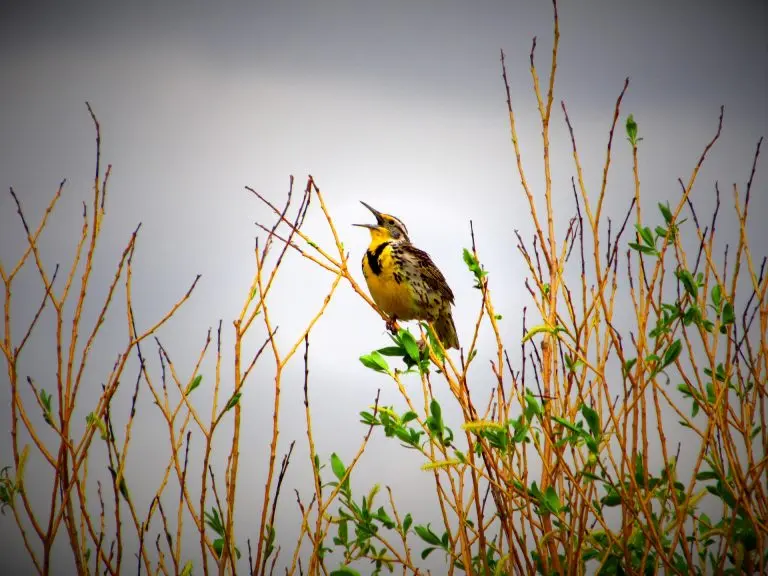
Western Meadowlarks with their bright yellow bellies and melodious song can brighten up your day. This is probably what makes them so popular, so popular in fact that they are the state bird of 6 states.
Western Meadowlarks are related to blackbirds and are about the size of a Robin with shades of brown and white upperparts and with a black V-shaped band across the bright yellow chest that turns gray in winter.
- Length: 6.3-10.2 in (16-26 cm)
- Weight: 3.1-4.1 oz (89-115 g)
- Wingspan: 16.1 in (41 cm)
Breeding in northern U.S and Canada before moving to more southern states. Those in the west and midwest remain all year.
Western Meadowlarks can be found foraging for insects and seeds from weeds and seeds, on the ground alone or in small flocks in grasslands, meadows, and fields.
4. Lesser Goldfinch
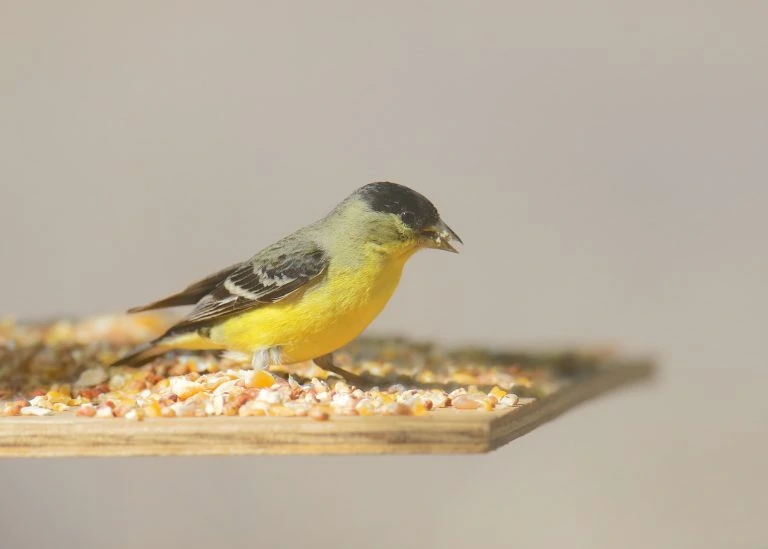
Lesser Goldfinches are tiny bright yellow and black songbirds with long pointed wings and short notched tails. They are darker on the back and with yellow bellies and chests. Females have olive backs and are more dull yellow underneath.
- Length: 3.5-4.3 in (9-11 cm)
- Weight: 0.3-0.4 oz (8-11.5 g)
- Wingspan: 5.9-7.9 in (15-20 cm)
Lesser Goldfinches live in the Southwest and Westcoast all year, but some may move down from higher elevations in winter.
Lesser Goldfinches can be found in large flocks in open habitats including thickets, weedy fields, forest clearings parks, and gardens. They forage for seeds, especially sunflower seeds, but also fruits from elderberry, coffeeberry, and buds from cottonwoods, willows, sycamores, and alders.
You can attract more Lesser Goldfinches to your yard with sunflower seeds and nyjer in tube feeders or platform feeders.
5. Prairie Warbler
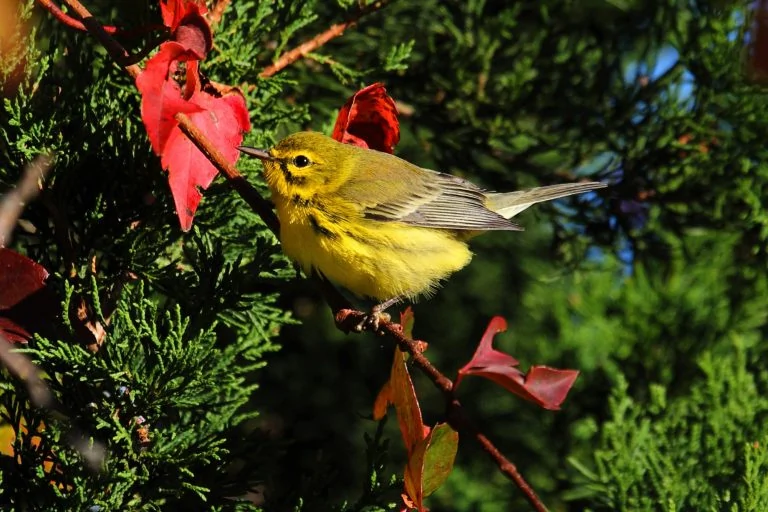
These small songbirds are olive green on the back and yellow on the throat and belly. They have black streaks on the sides and a dark semicircle under the eye. Female Prairie Warblers are duller in color.
- Length: 4.3 in (11 cm)
- Weight: 0.2-0.3 oz (6.4-8.8 g)
They breed over the eastern and southeastern states and spend the winter in Florida and the Caribbean and some coastal areas in Central America.
Those in Florida that remain all year are considered to be separate subspecies and are slightly larger.
Although called a prairie warbler they actually live in fields and forests
6. Orange-crowned Warbler
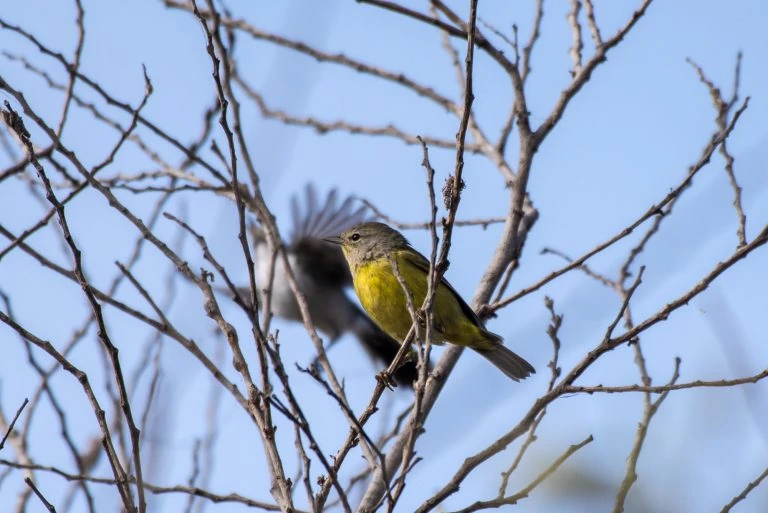
Orange-crowned Warblers are not as brightly colored as other warblers with their yellow-olive coloring, which is more yellow on the Pacific Coast. The orange crown is rarely seen.
They are darker on the back and with yellow bellies and chests.
- Length: 4.3-5.5 in (11-14 cm)
- Weight: 0.3-0.4 oz (7-11 g)
- Wingspan: 7.5 in (19 cm)
Breeding in Canada and western states before migrating to the Pacific, East and Gulf Coasts and Mexico. Orange-crowned Warblers can also be seen during migration across all states.
Orange-crowned Warblers can be found in shrubs and low vegetation and breed in open woodland.
Their diet consists mainly of insects and spiders such as spiders, caterpillars, and flies. They will also eat fruit, berries, and seeds and regularly visit backyard feeders.
To attract more Orange-crowned Warblers to your yard try suet and peanut butter or hummingbird feeders with sugar water nectar.
7. Prothonotary warbler
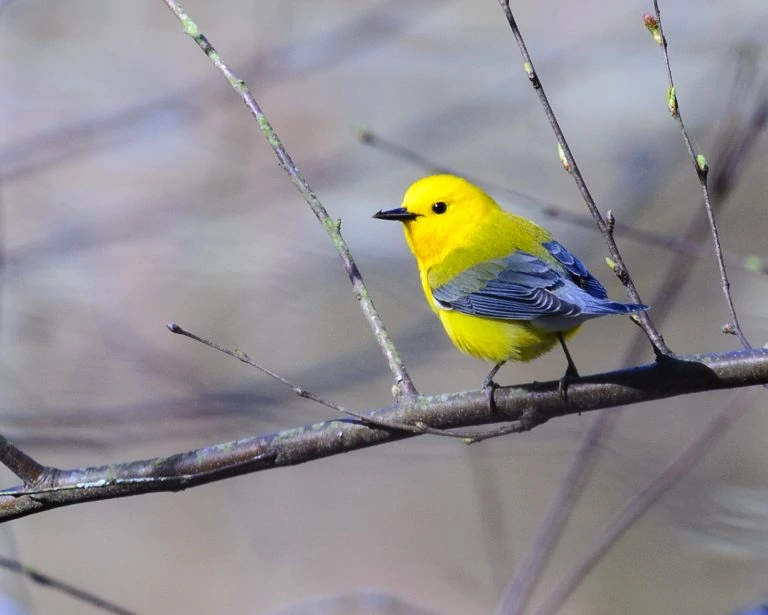
A warbler that breeds in eastern US states so more chances to spot them. The males are bright yellow and blue-winged so a bright contrast to watch for. Streams and wet woodlands are your best bet.
Prothonotary Warblers are bright yellow with blue-gray wings and tails. Females are less bright than males.
Unusual for warblers, Prothonotary Warblers breed in eastern and southeastern states before migrating to Central and South America.
They breed in wet wooded areas that are flooded, near streams, or in swamps.
Prothonotary Warblers eat spiders, insects and snails. In winter they will also eat fruit and seeds.
8. Orchard Oriole Female
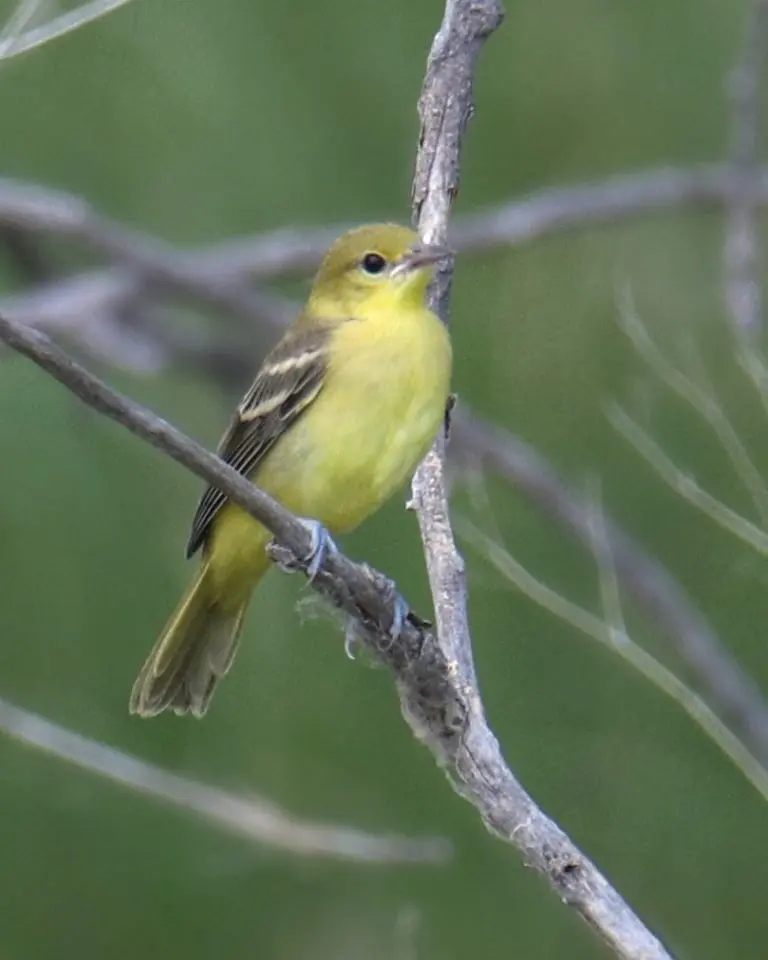
Orchard Orioles females are greenish-yellow overall, paler underneath and darker on the back, with darker wings and white wingbars. Males look very different with black heads and backs and with reddish undersides.
- Length: 5.9-7.1 in (15-18 cm)
- Weight: 0.6-1.0 oz (16-28 g)
- Wingspan: 9.8 in (25 cm)
Orchard Orioles breed in central and eastern states in summer, before migrating south to Mexico and Central America.
Preferring open woodland, Orchard Orioles can also be found along river banks and open shrubland and farms as well as backyards. They build hanging pouch-like nests.
Their diet is mostly insects such as ants, caterpillars, beetles, and grasshoppers, as well as spiders. they will also drink nectar from flowers and eat fruit such as mulberries and chokeberries.
To attract Orchard Orioles to your yard try hummingbird feeders or platform feeders with cut oranges or mango. Also, plant native berry plants such as mulberries or chokeberries.
9. Western Tanager
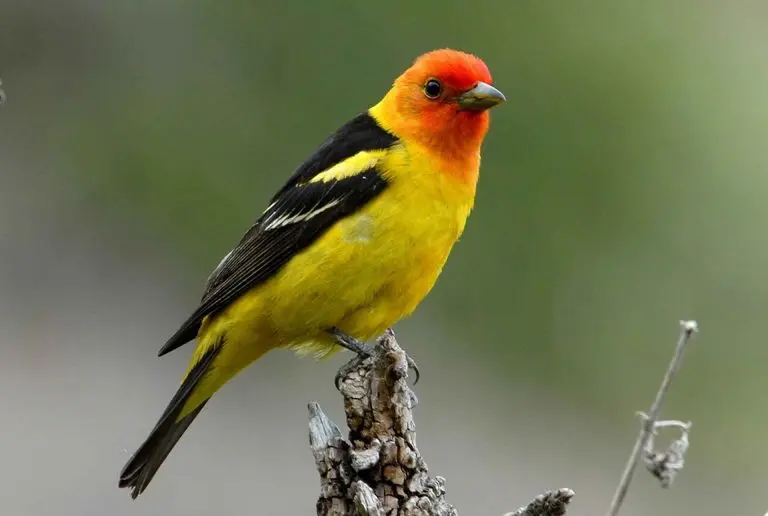
Western Tanagers have a flaming orange-red head, yellow body, and black wings.
- Length: 6.3-7.5 in (16-19 cm)
- Weight: 0.8-1.3 oz (24-36 g)
They breed in western US states and into Canada. They can be seen during migration in the east and south of this range. Winter is spent in Mexico and Central America.
They live in open conifer forests but stay hidden in the canopy, despite their bright coloring. The red coloring probably comes from eating insects that produce a pigment that the Western Tanagers cannot produce themselves.
You can attract Western Tanagers with dried fruit, cut oranges, and other fruits from bird feeders.
10. Canada Warbler
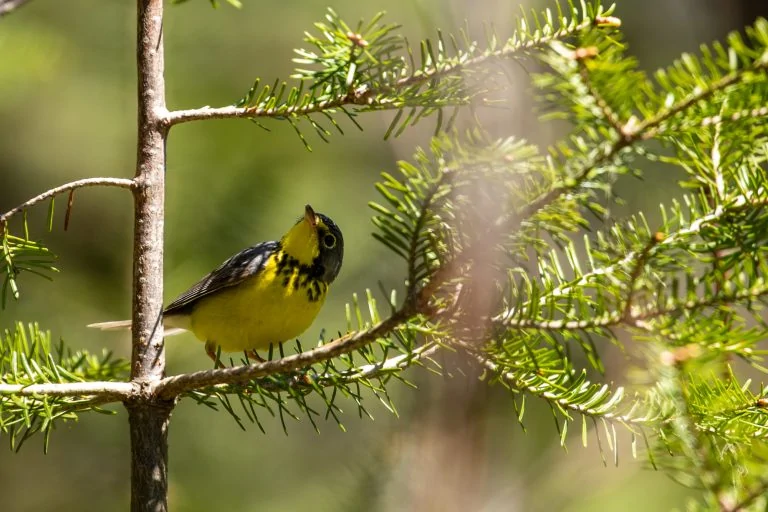
Canada Warblers are similar in appearance to the Magnolia Warbler and have a similar range. However, they are grayish-black on the back and the black ‘necklace’ does not extend over the belly, in the males, only over the chest. They have yellow bellies, chests and throats.
Females and immatures are similar but paler on the back and with a less prominent ‘necklace’
- Length: 4.7-5.9 in (12-15 cm)
- Weight: 0.3-0.5 oz (9-13 g)
- Wingspan: 6.7-8.7 in (17-22 cm)
Canada Warblers breed in Canada and northeastern US states but they can also be seen during migration across the eastern half of the US.
They live in mossy forests and forage for insects. They are difficult to find as their numbers have been declining.
11. Cape May Warbler
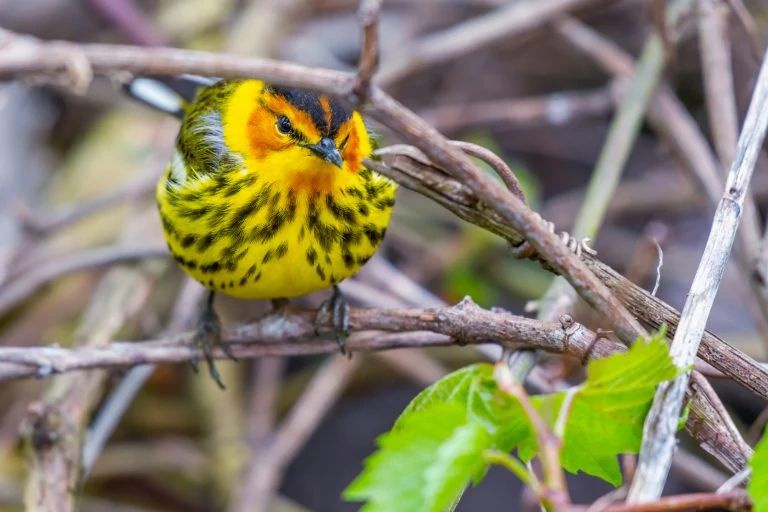
The tiger stripes on the Cape May Warblers chest and unusual dark crown set this warbler apart from the rest. Usually spotted during migration over eastern states.
Male Cape May Warblers are distinctive heads that are framed in a ring of yellow around the neck, chestnut cheeks and dark caps. They are mottled yellow-olive above and yellow with dark streaks below.
Female and immature Cape May Warblers are less bright and lack the head coloring of the males.
- Length: 4.7-5.1 in (12-13 cm)
- Weight: 0.4-0.5 oz (10.2-15.2 g)
- Wingspan: 7.9-8.7 in (20-22 cm)
Cape May Warblers winter in the Caribbean and a narrow band of the coast on the Yucatan Peninsula and Central America. They migrate to breeding grounds in Canada passing over Eastern US states.
They feed mainly in spruce budworm in summer but in winter they will eat fruit and nectar and will feed on hummingbird feeders.
12. Magnolia Warbler
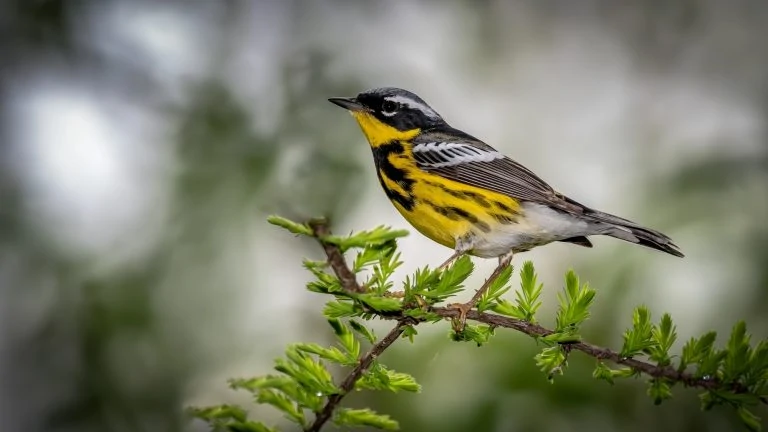
Although not as distinctive in color as some warblers on the easy to spot list they are common on low branches so it’s easier to spot them during migration.
Magnolia Warblers males are black on the back and yellow underneath. They have black streaking from a ‘necklace’ on their necks down over their bellies. Females are grayer on the back and lack the distinctive streaking down the belly.
- Length: 4.3-5.1 in (11-13 cm)
- Weight: 0.2-0.5 oz (6-15 g)
- Wingspan: 6.3-7.9 in (16-20 cm)
Magnolia Warblers breed across Canada and Northeastern US states in forests. They can be seen during migration in the Eastern US.
They spend the winter in Central America and the Caribbean.
13. Pine Warbler
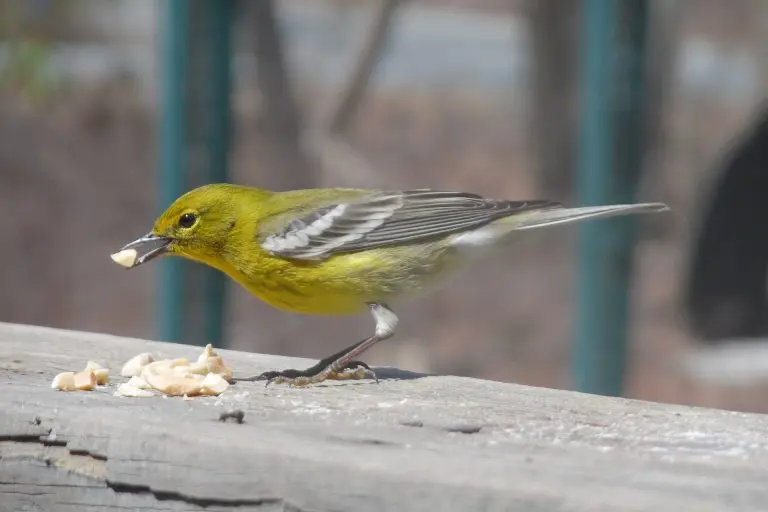
Pine Warblers are small plump yellow birds with olive backs, yellow throats, chests and upper bellies and white lower bellies, and gray wingbars. Females can appear browner and have more white on the belly.
- Length: 5.1-5.5 in (13-14 cm)
- Weight: 0.3-0.5 oz (9-15 g)
- Wingspan: 7.5-9.1 in (19-23 cm)
They breed in Northeastern US states before heading south. Some remain all year in Southeastern US states.
Pine Warblers can be found in pine forests, as their name would suggest, often high up in the trees. They eat caterpillars, beetles, spiders, and other insects and larvae and when the weather is colder they will eat fruit and seeds.
You can attract more Pine Warblers with tube feeders and platform feeders with millet, cracked corn, sunflower seeds, peanut hearts, and suet. Also plant native fruits and vines such as bayberry, grape, sumac, and Virginia creeper.
14. Yellow Warbler
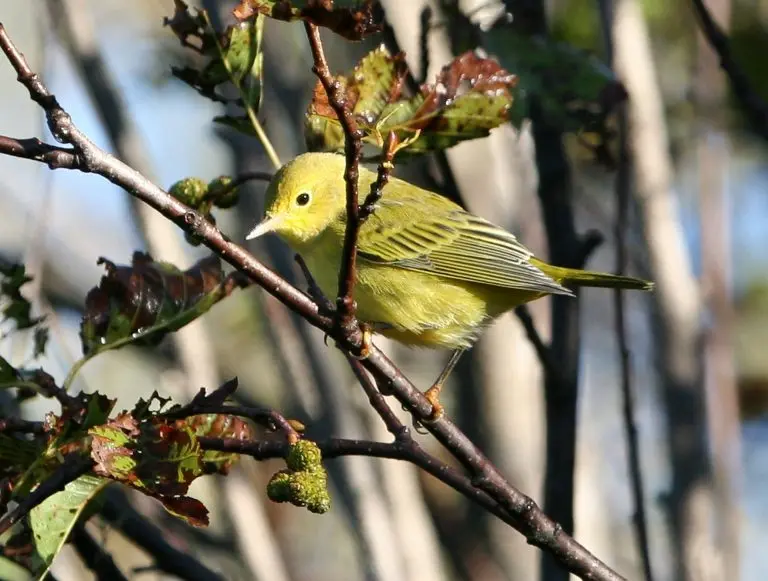
Yellow Warblers are small bright yellow birds with a yellow-green back, and the males have chestnut streaks on the breast, which are a common sight in summer.
- Length: 4.7-5.1 in (12-13 cm)
- Weight: 0.3-0.4 oz (9-11 g)
- Wingspan: 6.3-7.9 in (16-20 cm)
Yellow Warblers migrate a long distance to breed over much of North America before heading into Central and northern South America for winter.
They can be seen during migration in the far south.
Yellow Warblers can be found along streams and wetlands in thickets and along the edges of fields foraging for insects, including caterpillars, midges, beetles, bugs, and wasps.
Warblers are hard to attract to your backyard as they are shy and eat mainly insects, but you can try suet, oranges, and peanut butter.
15. Orchard Oriole Female

Orchard Orioles females are greenish-yellow overall, paler underneath and darker on the back, with darker wings and white wingbars. Males look very different with black heads and backs and with reddish undersides.
- Length: 5.9-7.1 in (15-18 cm)
- Weight: 0.6-1.0 oz (16-28 g)
- Wingspan: 9.8 in (25 cm)
Orchard Orioles breed in central and eastern states in summer, before migrating south to Mexico and Central America.
Preferring open woodland, Orchard Orioles can also be found along river banks and open shrubland and farms as well as backyards. They build hanging pouch-like nests.
Their diet is mostly insects such as ants, caterpillars, beetles, and grasshoppers, as well as spiders. they will also drink nectar from flowers and eat fruit such as mulberries and chokeberries.
To attract Orchard Orioles to your yard try hummingbird feeders or platform feeders with cut oranges or mango. Also, plant native berry plants such as mulberries or chokeberries.
16. Western Kingbird
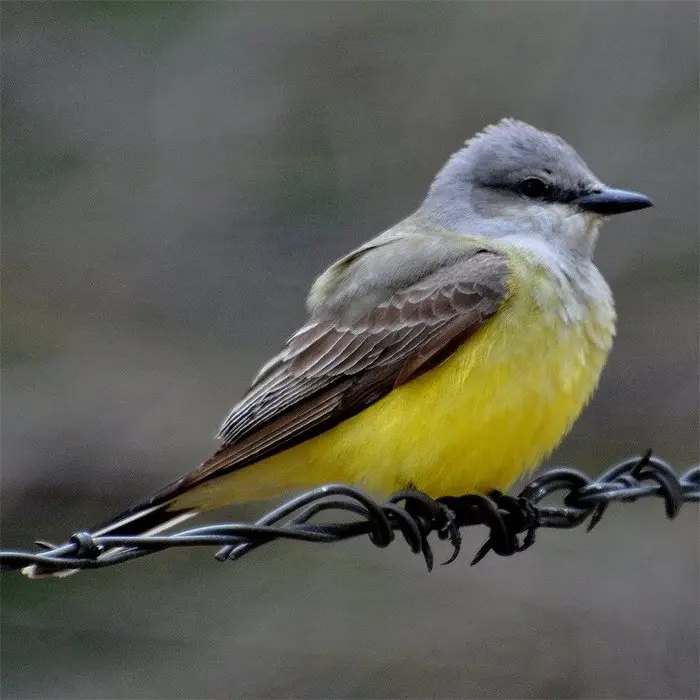
Western Kingbirds are large flycatchers with yellow bellies, whitish chests, gray heads, grayish-brown wings, and a darker tail.
- Length: 7.9-9.4 in (20-24 cm)
- Weight: 1.3-1.6 oz (37-46 g)
- Wingspan: 15.0-16.1 in (38-41 cm)
They breed in summer in western US states, the plains area and into Canada.
They are a familiar sight in summer before migrating to Mexico and Central America, some may overwinter in the south of Florida.
They live in open habitats and are often found perched on fences and utility lines waiting for insects to fly by before catching them in mid-flight.
They can often be found near the edge of woodlands so they can nest in the trees and forage in the open. They also nest in human-made structures.
You can attract more Western Kingbirds to your yard by making it insect-friendly and planting elderberry or hawthorn, which they will also eat the fruit from.
17. Baltimore Oriole Female
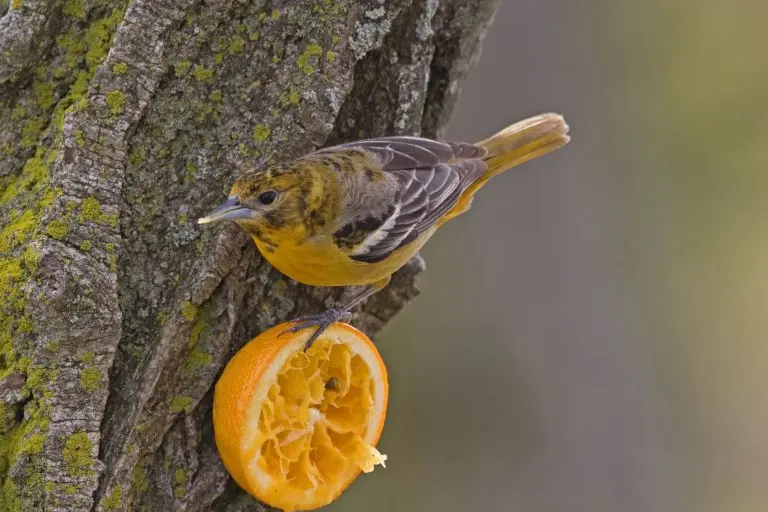
Baltimore Orioles females are yellowish underneath and on the head and grayish-brown on the wings, their backs or brownish-yellow. Adult males are bright orange and black with white wing bars on the black wings.
- Length: 6.7-7.5 in (17-19 cm)
- Weight: 1.1-1.4 oz (30-40 g)
- Wingspan: 9.1-11.8 in (23-30 cm)
Breeding in eastern and central North America from April, Baltimore Orioles then migrate to Florida, Central America, and the Caribbean for winter, leaving as early as July. They make incredible hanging bag-like nests woven from fibers.
Baltimore Orioles can be found high up in open woodland, riverbanks, and forest edges foraging for insects and fruit and they often come to parks and backyards. Their diet is fruit and insects.
To attract more Baltimore Orioles to your yard try oranges cut in half on a platform feeder or hanging from trees. Also, oriole feeders filled with sugar water.
18. Altamira Oriole
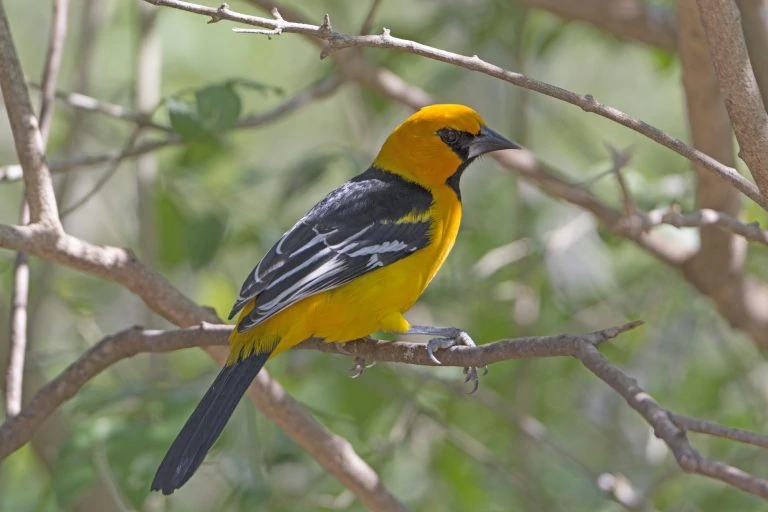
Altamira Orioles are bright yellowish-orange with black backs, wings and tails. They also have black around the eyes and down the throat. Juveniles are more yellow and have olive backs rather than black.
- Length: 8.3-9.8 in (21-25 cm)
- Weight: 1.7-2.3 oz (47-64 g)
- Wingspan: 14.2 in (36 cm)
Altamira Orioles are rare in the US except in the Rio Grande Valley, Texas and they remain year-round.
Look for them in backyards at sunflower or nectar feeders or in wildlife refuges in southeastern Texas and along the Gulf Coast of Central America. They prefer open woodlands.
Altamira Orioles stay in pairs year-round. Try to look for their amazing hanging nests that measure up to 2 feet long.
19. Audubons Oriole
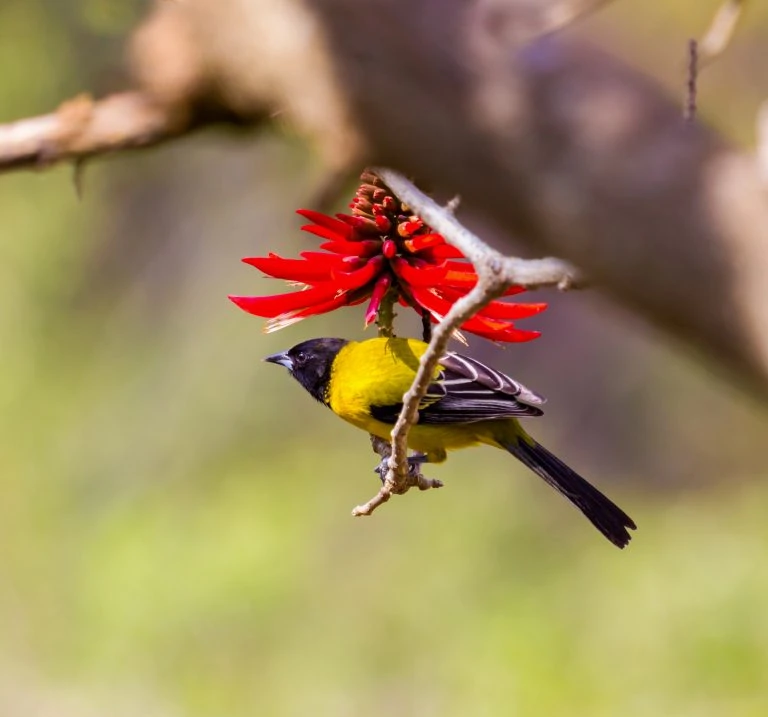
A bright yellow and black oriole with black wings and tail and a black head and throat. Males and females are similar.
- Length: 7.5-9.4 in (19-24 cm)
- Weight: 1.1-1.9 oz (31-53 g)
- Wingspan: 12.6 in (32 cm)
They have a small range and do not migrate. Audubon’s Orioles live in southeastern Texas and Mexico.
Audubon’s Orioles can be found in wooded areas or thickets and they will come to backyards for sunflower seeds and nectar feeders. They can be hard to see as they are shy and forage for insects and fruit in thick vegetation.
The nests of Audubon’s Orioles are often the favored new homes for cowbird eggs.
20. Eastern Meadowlark
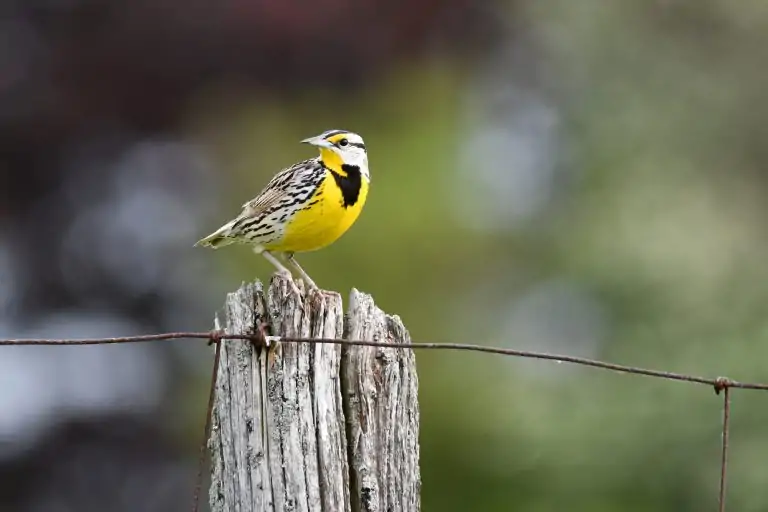
A medium-sized songbird that are bright yellow underneath and pale brown with black marks on the back. They have a distinctive black band across the chest.
- Length: 7.5-10.2 in (19-26 cm)
- Weight: 3.2-5.3 oz (90-150 g)
- Wingspan: 13.8-15.8 in (35-40 cm)
Found all year across eastern US states, but they will also breed in the northeast and into Canada before migrating south.
They can be found in grasslands and prairies eating insects. In winter they gather in large flocks in fields looking for seeds.
21. Yellow-throated Warbler
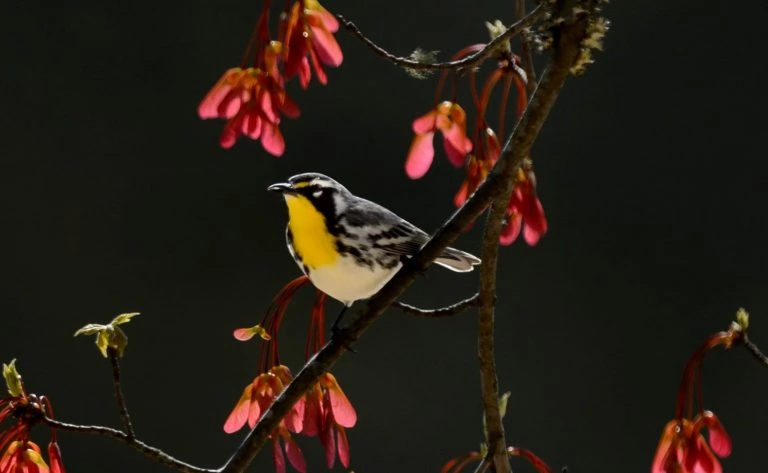
Similar in appearance to the Common Yellowthroat but with black streaks down their sides. The Yellow-throated Warbler has a gray and white body with yellow extending down the throat to the belly.
- Length: 5.1-5.5 in (13-14 cm)
- Weight: 0.3-0.4 oz (9-11 g)
- Wingspan: 8.3 in (21 cm)
Yellow-throated Warblers breed across the southeastern states and spend winter in Florida, the Caribbean and along the Gulf Coast into Central America. Some birds may remain resident all year in Florida.
They spend their time at the top of pine trees but may forage lower down during migration.
22. Nashville Warbler
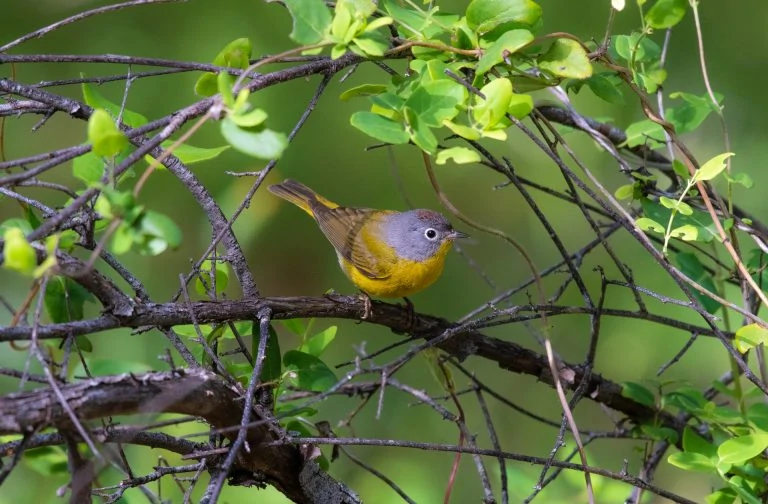
Nashville Warblers are mostly yellow with a green back and gray head.
- Length: 4.3-5.1 in (11-13 cm)
- Weight: 0.2-0.5 oz (6.7-13.9 g)
- Wingspan: 6.7-7.9 in (17-20 cm)
Breeding in northeastern US states and Canada and a smaller population in northwestern Us states and into British Columbia. They can also be seen during migration in most states.
They can be seen in scrubby habitats and low deciduous forests hunting for insects.
23. Palm Warbler
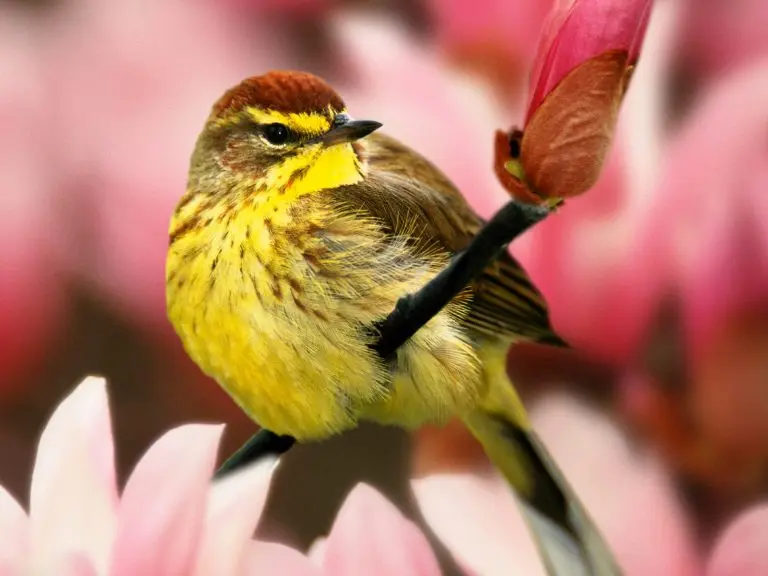
The palm warbler has a rusty red patch on the top of its head and is a browny-olive color over the rest of its body.
- Length: 4.7-5.5 in (12-14 cm)
- Weight: 0.3-0.5 oz (7-13 g)
- Wingspan: 7.9-8.3 in (20-21 cm)
The breed in Canada but can be found in eastern states during the migration and all year along the far south coast and Florida.
Spring and fall is the best time to spot them in weedy fields, forest edges, and scrubby areas. They are often found foraging along the ground for insects, mixed in with other birds such as Sparrows, Juncos, and Yellow-rumped Warblers.
To attract more Palm Warblers to your backyard try planting native plants that attract insects and bayberry or hawthorn for their berries.
24. Cedar Waxwing
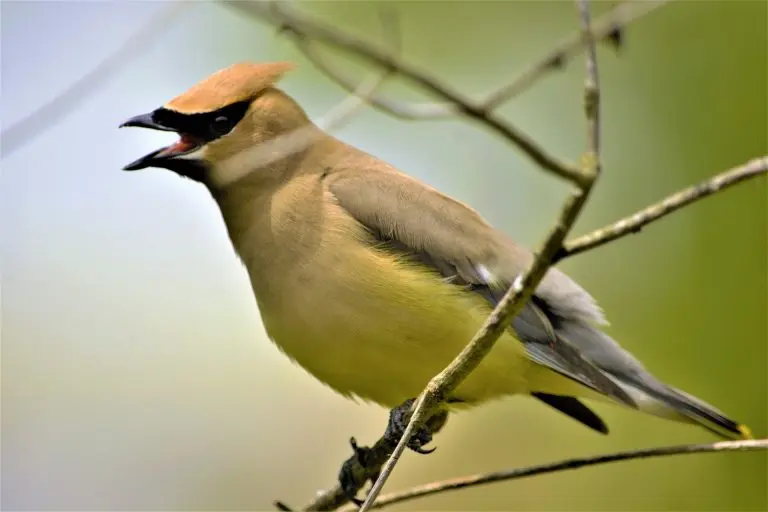
Cedar Waxwings are elegant social birds that are pale brown on the head, chest, and crest, which fades to gray on the back and wings and tail.
Their belly is pale yellow and there is bright yellow on the tip. They have a narrow black mask over their eyes and bright red on the wingtips.
- Length: 5.5-6.7 in (14-17 cm)
- Weight: 1.1 oz (32 g)
- Wingspan: 8.7-11.8 in (22-30 cm)
Cedar Waxwings breed in Canada before heading to the southern US for winter. They are resident all year in Northern US states.
They make a high-pitched call and can be found in berry bushes, in woodlands, and along streams.
To attract Cedar Waxwings to your backyard plant native trees and shrubs that have small fruit such as serviceberry, dogwood, juniper, winterberry, and hawthorn. You can also try fruit on platform feeders.
25. Evening Grosbeak

Evening Grosbeak males are yellow and black with a white patch on the wings. Females and immature males are mostly gray.
- Length: 6.3-7.1 in (16-18 cm)
- Weight: 1.9-2.6 oz (53-74 g)
- Wingspan: 11.8-14.2 in (30-36 cm)
They live all year in southern Canada and the Rocky Mountains in coniferous forests. They may move as far as southern US states if pine cone crops are scarce.
Evening Grosbeaks may turn up in winter at sunflower seed feeders if pine cone crops are bad.
26. Scott’s Oriole
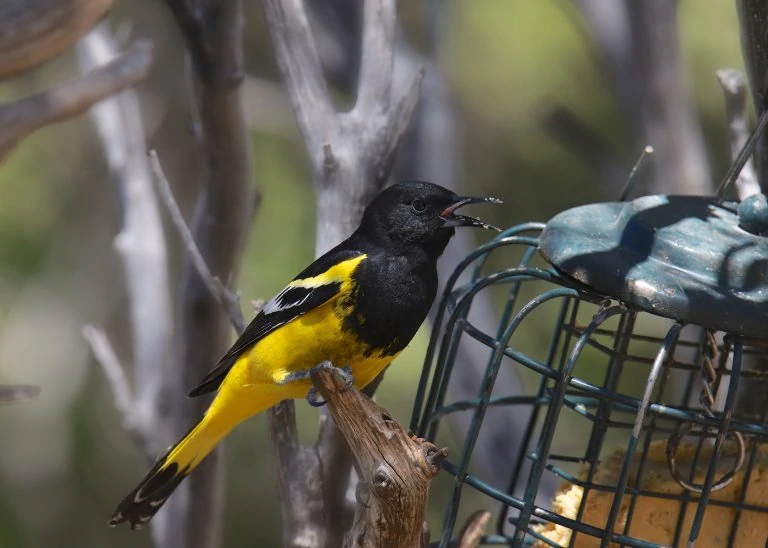
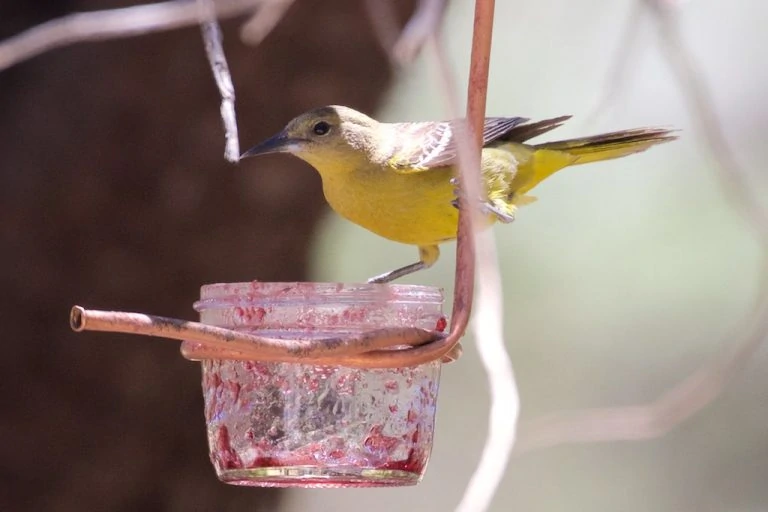
A large distinctive oriole with a bright yellow underside and black head and back in the males. Females are a paler yellow with olive-brown backs.
- Length: 9.1 in (23 cm)
- Weight: 1.1-1.4 oz (32-41 g)
- Wingspan: 12.6 in (32 cm)
Scott’s Orioles breed in southwestern US states and can be found in arid areas feeding on insects in yuccas.
27. Spot Breasted Oriole
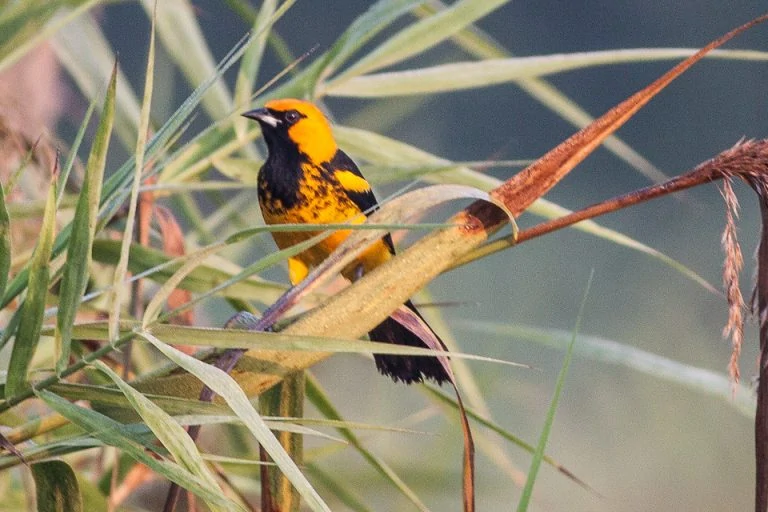
Spot-breasted Orioles are black and orange with black spotting on their breast and white on the wing edges. They have black around the face and chest and are black on the back, wings and tail. Juveniles are more yellow in color with dark backs, wings and tails.
- Length: 8.3-9.4 in (21-24 cm)
- Weight: 1.8 oz (50 g)
Spot-breasted Orioles can be found in Florida and along the Gulf Coast but they are not very common in the US. They mostly live in Mexico and Central America along the Pacific Coast.
They live in open woodlands and will visit backyards for fruit and nectar.
28. Baltimore Oriole Female
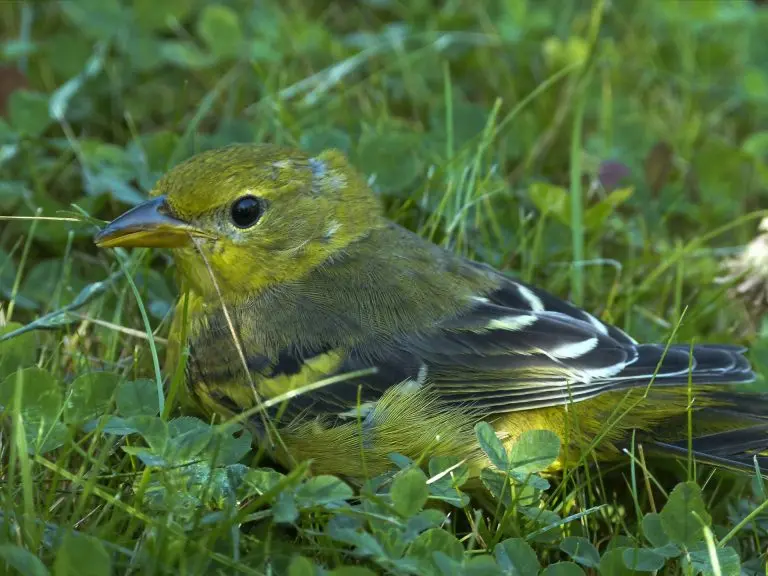
Baltimore Orioles are a colorful sign of spring in the east of North America. The adult males are bright orange and black with white wing bars on the black wings.
Females are yellowish underneath and on the head and grayish-brown on the wings, their backs or brownish-yellow. They are about the size of a Robin but more slender and are members of the blackbird family.
- Length: 6.7-7.5 in (17-19 cm)
- Weight: 1.1-1.4 oz (30-40 g)
- Wingspan: 9.1-11.8 in (23-30 cm)
Breeding in Eastern and Central States, including central-southern Canadian provinces and along the southern border with the US, from April.
Baltimore Orioles, then migrate to Florida, Central America, and the Caribbean for winter, leaving as early as July.
They make incredible hanging bag-like nests woven from fibers.
Baltimore Orioles can be found high up in open woodland, riverbanks, and forest edges foraging for insects and fruit and they often come to parks and backyards.
Their diet is insects such as beetles, crickets, and grasshoppers as well as spiders and snails and they help eat pest species. They eat a wide variety of fruits and can damage crops such as raspberries, mulberries, cherries, bananas, and oranges.
To attract more Baltimore Orioles to your yard try oranges cut in half on a platform feeder or hanging from trees. Also, oriole feeders filled with sugar water. Plant fruit and nectar plants such as raspberries, crab apples, and trumpet vines.
29. Streaked Backed Oriole Female
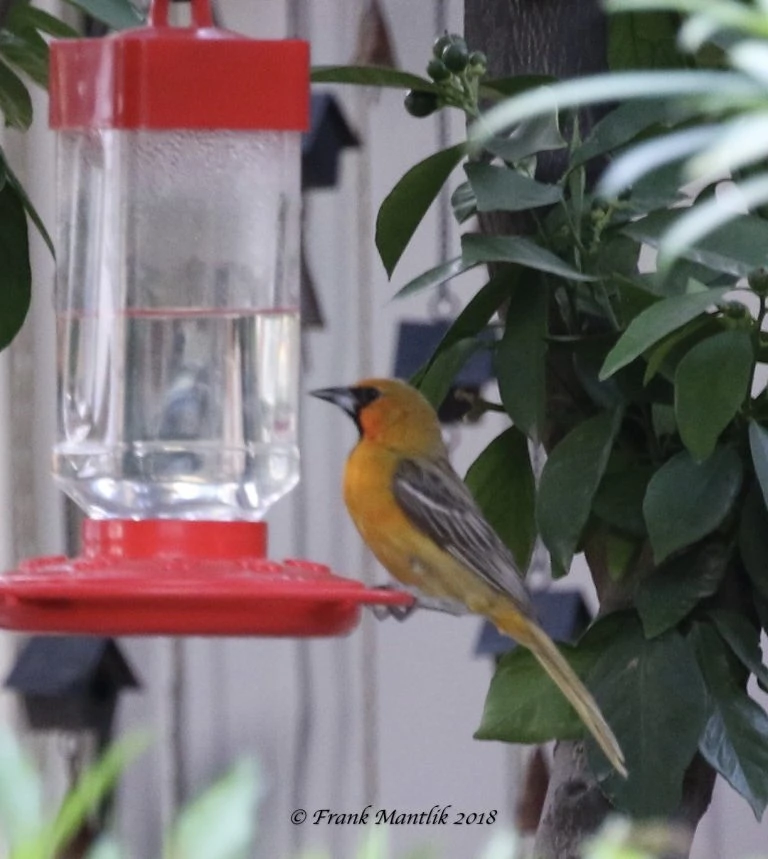
Streak-backed Orioles are orange and black orioles with orange heads and undersides and black-streaked wings and a black tail. They have black around the eyes and chin.
They are rare in the US but can be seen in the southwest. Mexico and Central America is their main habitat.
They are found in tropical woodland, grassland and backyards.
30. Hooded Oriole
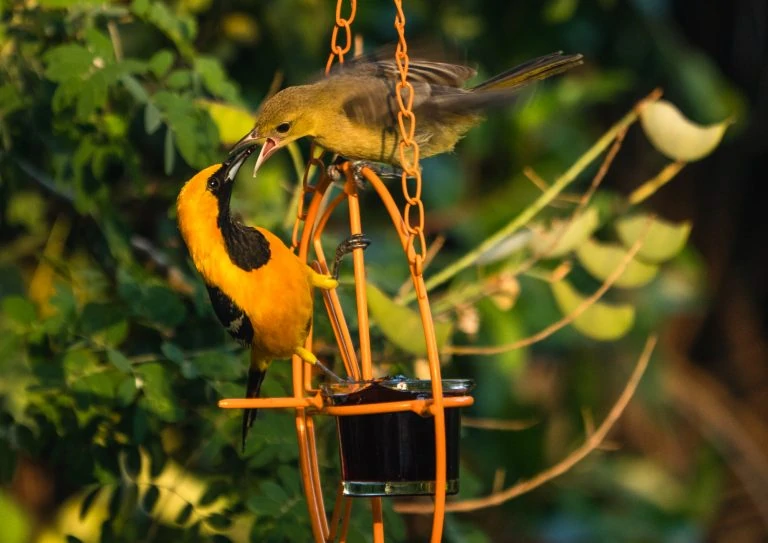
Male Hooded Orioles range from bright yellow to bright orange, with black throats and backs. Females and immatures are more yellow with grayish wings. Females lack the black face markings.
- Length: 7.1-7.9 in (18-20 cm)
- Weight: 0.8 oz (24 g)
- Wingspan: 9.1-11.0 in (23-28 cm)
They breed in the southwestern US states, making hanging nests on the undersides of palm fronds.
They will come to nectar feeders or use fruit to attract orioles.
31. Wilson’s Warbler
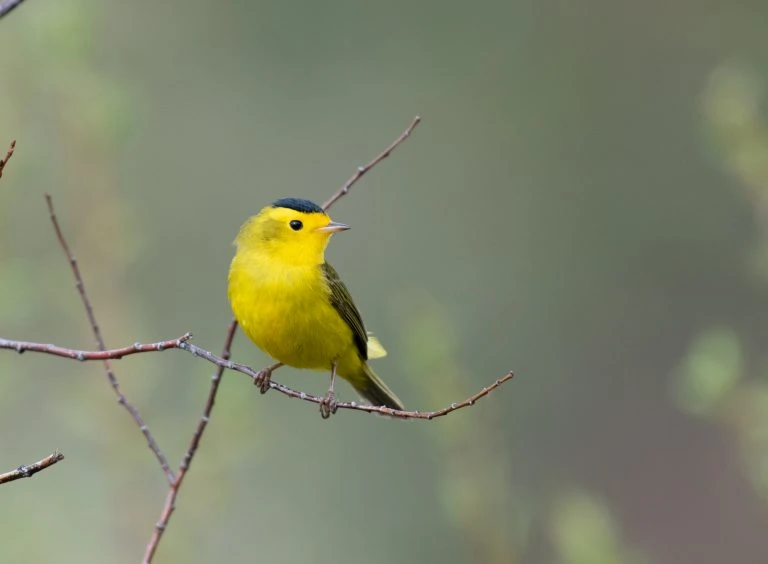
Wilson’s Warblers are small yellow warblers with a black cap in the males and olive cap in females.
- Length: 3.9-4.7 in (10-12 cm)
- Weight: 0.2-0.3 oz (5-10 g)
- Wingspan: 5.5-6.7 in (14-17 cm)
Breeding in Canada, Alaska and northwestern states, Wilson’s Warblers can also be seen across all states during migration. They winter in Mexico and Central America.
To find Wilson’s Warblers look along streams in thickets.
32. Hooded Warbler
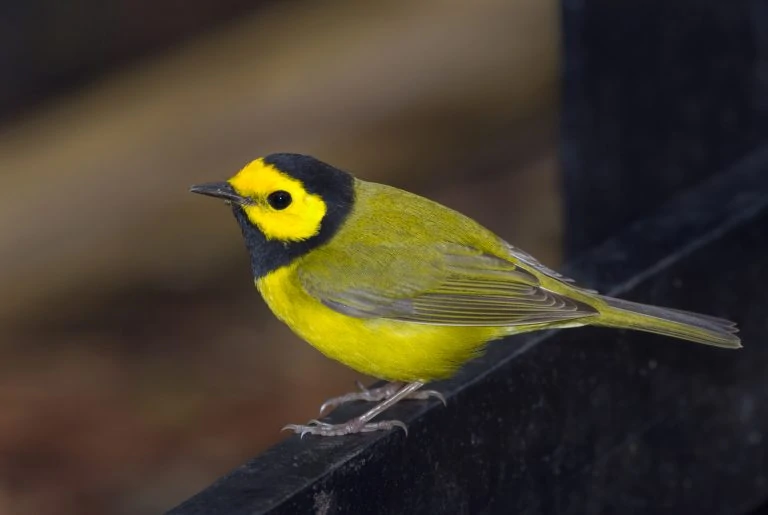
Male Hooded Warblers have a bright yellow face with a distinctive black hood and throat. They are yellow underneath and olive-green above.
Females and immature are more yellow and without the black face markings.
- Length: 5.1 in (13 cm)
- Weight: 0.3-0.4 oz (9-12 g)
- Wingspan: 6.9 in (17.5 cm)
They breed in eastern states before heading south into Central America and the Caribbean for winter.
Forests with dense understories to hunt for insects are the best place to find Hooded Warblers.
33. Williamson’s Sapsucker Male
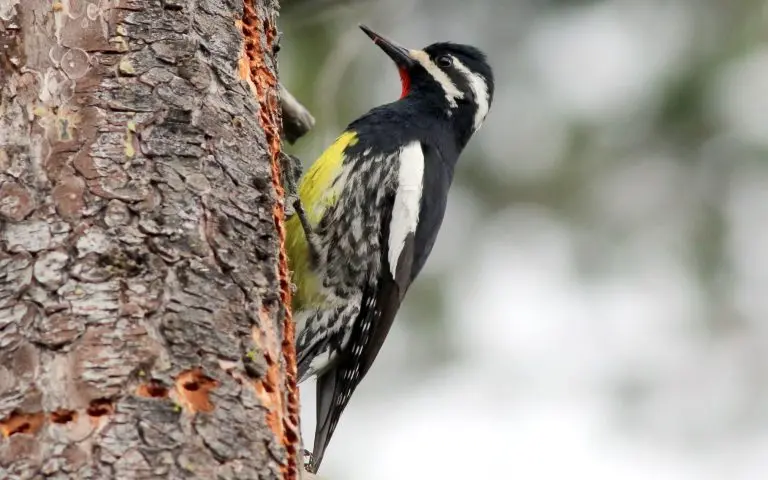
Williamson’s Sapsucker males are more black than many woodpeckers with a glossy black back, vertical wing patches, red throat, and yellow belly. Females have the more common black and white pattern on their back and they have a brown head and black breast patch.
- Length: 8.3-9.8 in (21-25 cm)
- Weight: 1.6-1.9 oz (44-55 g)
Williamson’s Sapsuckers are migratory and spend the summer breeding in the mountainous west and the winter in southern states and Mexico.
Feeding mostly on sap from conifer trees, especially in spring, and then more insects such as ants, beetles, and flies in summer. Winter food is often fruit and seeds.
34. Great Crested Flycatcher
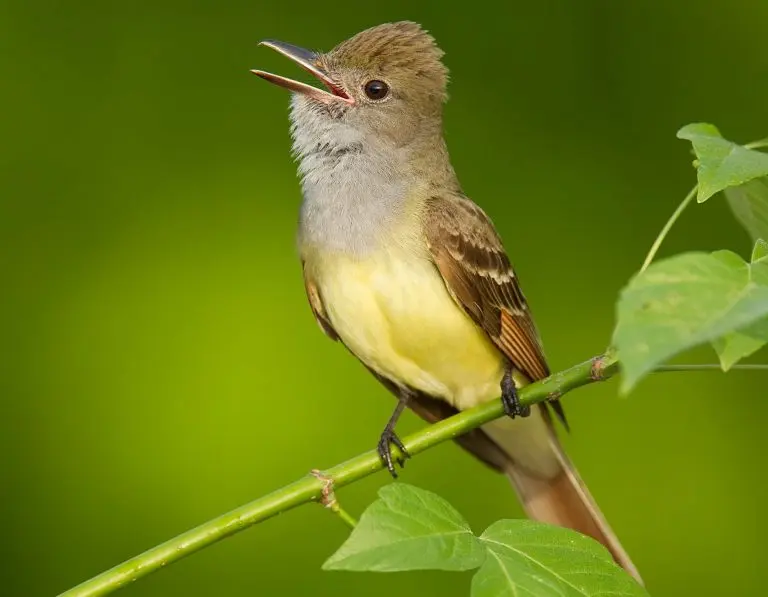
Great Crested Flycatchers are brown on the back with a yellow belly and gray throat. They have reddish flashed in the wing and tail feathers. The crest is not very obvious.
- Length: 6.7-8.3 in (17-21 cm)
- Weight: 0.9-1.4 oz (27-40 g)
- Wingspan: 13.4 in (34 cm)
Great Crested Flycatchers breed over much of Eastern North America and spend the winter in southern Florida, southern Mexico, and Central America.
They sit perched up high in woodland waiting for large insects flying such as butterflies, grasshoppers, moths, wasps, and also spiders. They can be found in mixed woodlands and at the edges of clearings, parks, and tree-lined neighborhoods or perched on fenceposts or other man-made structures. They will also eat berries and small fruit.
To attract more Great Crested Flycatchers to your backyard try planting native species of plants and leaving brush piles to attract insects. plant berry-producing plants and put up a nest box as they readily take up residence in them.
35. Yellow Bellied Sapsucker
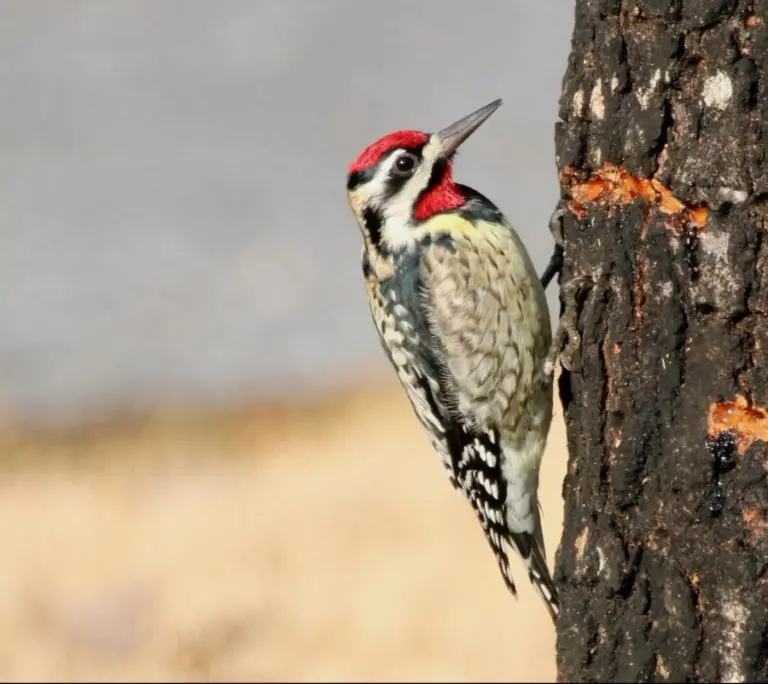
The Yellow-bellied Sapsucker is relatively small and is about the size of a robin. They are mostly black and white with red foreheads and the male has a red throat. Their bellies are pale yellow with lots of markings.
Length: 7.1-8.7 in (18-22 cm)
Weight: 1.5-1.9 oz (43-55 g)
Wingspan: 13.4-15.8 in (34-40 cm)
Breeding in Canada and northeastern US states the Yellow-bellied Sapsucker migrates for winter to southeastern US states, Central America and the Caribbean.
Yellow-bellied Sapsuckers make holes in trees and use their brush-tipped tongues to get the sap out. They make neat rows of holes in horizontal rows so look out for these in young paper birch, yellow birch, red or sugar maple, and hickory trees. The holes need to be maintained to ensure a flow of sap. They make a loud mewing call and they nest in tree cavities and usually have 5-6 white eggs.
Where to spot Yellow-bellied Sapsuckers:
Young deciduous forests often on birch or maple trees where they make neat rows of sapwells to feed.
How to attract more Yellow-bellied Sapsuckers to your backyard:
Although not usually found at bird feeders Yellow-bellied Sapsuckers sometimes will come for suet so try putting up squirrel-proof suet feeders and try mealworm suet or peanut butter suet.

